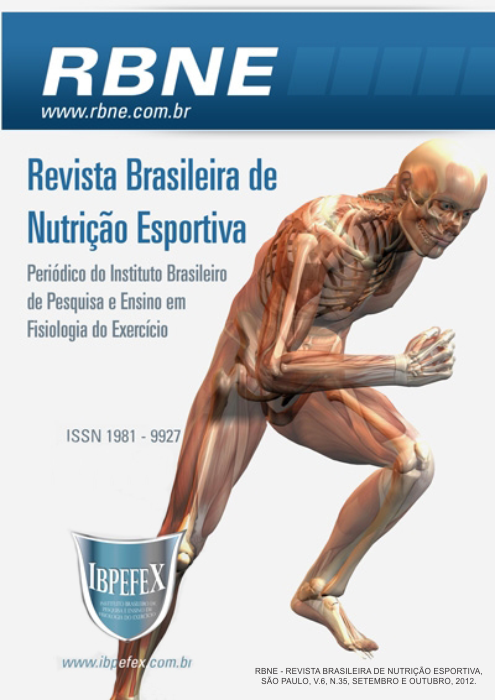The association between nutritional orientation and weight exercise for muscle hypertrophy.
Abstract
The regular practice of physical exercises, linked to healthy eating, is increasingly associated with better quality of life, taking people to gyms for bodybuilding by promoting reduction of body fat and muscle hypertrophy. The research aimed to analyze the relationship of nutritional guidance to strength exercise on muscular hypertrophy of 30 bodybuilders of a gym in the city of Belford Roxo-RJ. An anthropometric assessment was conducted for three consecutive months and the evaluation of eating habits was through a Food Frequency Questionnaire (FFQ) applied at the beginning and end of the study.The sample was equally divided into the Group A (Control) and Group B (Experimental) which received the guidelines.The IMC revealed that 46.67% of Group A and 66.67% of Group B were eutrophic. In the latest assessment, the TSF of both groups presented 93.33% of eutrophy. In Group B, the percentage of AC with risk for malnutrition was changed to eutrophy and the percentage of individuals with muscular developed remained 26.67% and in the group A there was a decrease. TheGroup B began to consume more fiber and unsaturated lipids daily. The consumption of carbohydrates and proteins of the groups proved to be relevant. In Group B, the reduced consumption of saturated fats and the exercise may have influenced the reduction of TSF and BMI in this group. It was concluded that healthy eating acquired through an adequate nutritional orientation was essential to the positive changes in anthropometry of the individuals.
References
-Chandler, T.J.; Brown, L.E. Treinamento de força para o desempenho humano. Porto Alegre. Artmed. 2009. p. 512.
-Círico, D.; Oliveira, A.F. Avaliação nutricional de praticantes de musculação com objetivo de hipertrofia muscular do município de Cascavel-Paraná. TCC Graduação em Nutrição. Faculdade Assis Gurgacz. Cascavel. 2005.
-Costa, P.R.F.; Assis, A.M.O.; Silva, M.C.M.; Santana, M.L.P.; Dias, J.C.; Pinheiro, S.M.C.; Santos, N.S. Mudança nos parâmetros antropométricos: a influência de um programa de intervenção nutricional e exercício físico em mulheres adultas. Cad. Saúde Pública. Rio de Janeiro. Vol. 25. Num. 8. 2009. p. 1763-1773.
-Crozeta, C.; Oliveira, G.K. Análise do perfil alimentar de mulheres com sobrepeso, praticantes de treinamento de força em academias de Curitiba-PR. Revista Brasileira de Nutrição Esportiva. São Paulo. Vol. 3. Num. 17. 2009. p. 432-441.
-Frisancho, A.R. Anthropometric Standards for the assesment of growth and nutritional status. Ann Arbor: University of Michigan Press.1990.
-Gentil, P. Bases científicas do treinamento de hipertrofia. Rio de Janeiro. Sprint. 2011. p. 192.
-Gonçalves, M.P.; Alchieri, J.C. Motivação à prática de atividades físicas: um estudo com praticantes não atletas. Psico-USF. Itatiba. Vol. 15. Num.1. 2010. p. 125-134.
-Hernandez, A.J.; Nahas, R.M. Modificações dietéticas, reposição hídrica, suplementos alimentares e drogas: comprovação de ação ergogênica e potenciais riscos para a saúde. Rev. Bras. Med. Esporte. São Paulo. Vol. 15. Num. 2. 2009. p. 3-12.
-Hirschbruch, M.D.; Carvalho, J.R. Nutrição Esportiva: uma visão prática. Manole. 2008. p. 430.
-Kamel, D.; Kamel, J.G.N. Nutrição e atividade física. Rio de Janeiro. Sprint. 2003. p. 120.
-Lopes, J.A.; Longo, G.Z.; Peres, K.G.; Boing, A.F.; Arruda, M.P. Fatores associados à atividade física insuficiente em adultos: estudo de base populacional no sul do Brasil. Rev. Bras. Epidemiol. São Paulo. Vol. 13. Num. 4. 2010. p. 689-698.
-Philippi, S.T. Pirâmide dos alimentos: fundamentos básicos da nutrição. Manole. 2008. p. 387.
-Piaia, C.C.; Rocha, F.Y.; Vale, G.D.B.F.G. Nutrição no exercício físico e controle do peso corporal. Revista Brasileira de Nutrição Esportiva. São Paulo. Vol. 1. Num. 4. 2007. p. 40-48.
-Rossi, L.; Caruso, L.; Galante A.P. Avaliação nutricional: novas perspectivas. São Paulo. Roca. 2009. p. 422.
-Santos, V.H.A.; Nascimento, W.F.; Liberali, R. O treinamento de resistência muscular localizada como intervenção no emagrecimento. Revista Brasileira de Obesidade, Nutrição e Emagrecimento. São Paulo. Vol. 2. Num. 7. 2008. p. 34-43.
-Silva, R.S.; Silva, I.; Silva, R.A; Souza, L.; Tomasi, E. Atividade física e qualidade de vida. Ciência & Saúde Coletiva. Rio de Janeiro. Vol. 15. Num. 1. 2010. p. 115-120.
-Souza, E. B. Transição nutricional no Brasil: análise dos principais fatores. Cadernos UniFOA, Volta Redonda. Vol. 5. Num. 13. 2010. p. 49-53.
-Theodoro, H.; Ricalde, S.R.; Amaro, F.S. Avaliação nutricional e autopercepção corporal de praticantes de musculação em academias de Caxias do Sul -RS. Rev. Bras. Med. Esporte. Niterói. Vol. 15. Num. 4. 2009. p. 291-294.
-World Health Organization. Physical status: the use and interpretation of anthropometry. Geneva. .1995. Disponível em: <http://www.who.int/childgrowth/publications/physical_status/en/>. Acesso em: 07 nov. 2011.
Authors who publish in this journal agree to the following terms:
- Authors retain the copyright and grant the journal the right of first publication, with work simultaneously licensed under the Creative Commons Attribution License BY-NC which allows the sharing of the work with acknowledgment of the authorship of the work and initial publication in this journal.
- Authors are authorized to enter into additional contracts separately for non-exclusive distribution of the version of the work published in this journal (eg, publishing in institutional repository or book chapter), with acknowledgment of authorship and initial publication in this journal.
- Authors are allowed and encouraged to post and distribute their work online (eg, in institutional repositories or on their personal page) at any point before or during the editorial process, as this can bring about productive change as well as increase impact and impact. citation of published work (See The Effect of Free Access).






